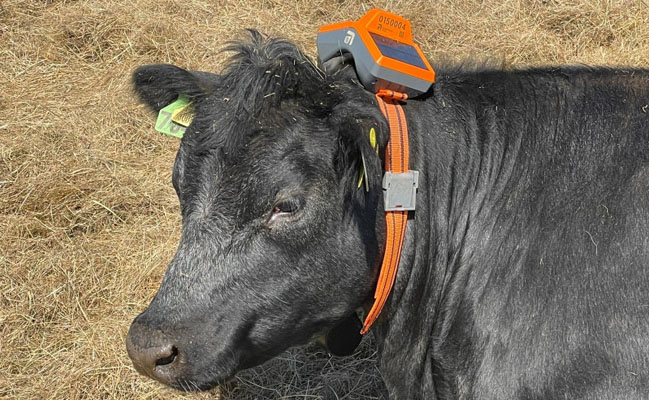UK
Modern technology helps improve cattle management at Sutton Park

Birmingham: Collars are to be fitted to 78 head of cattle for their annual period of grazing at Sutton Park in a new virtual fencing solution that helps better manage the land and the animals living on it.
Virtual fencing is a new technology that has no physical structure above or below ground – instead the animal is tracked by a GPS collar worn around its neck. The collar receives the positioning of a virtual fence line, drawn on a computer programme and then transmitted from the device, acting a base station.
The collar-wearing animal receives an audible cue from the collar as it approaches a virtual fence line, followed by a short electric pulse if it then reaches the line.
If an animal is chased through the fence line, the virtual fence system automatically extends the fence out to encompass the animal. Provided the animal walks back, no further audio cues or pulses are given and the fence line returns to the original position.
The short pulse delivered from the collar is much milder than that from a traditional electric fence, and is designed to be uncomfortable rather than painful.
Cattle receiving the pulse do not become agitated but simply turn away from the fence. Cattle are trained beforehand in a controlled environment and have been shown to quickly learn to respond to the audible cue without the need to deliver a pulse.
The system has a number of animal welfare protections, including timeouts, automatic shutdowns and alert notifications to the farmer. All of these are designed to prevent an animal from receiving excessive pulses. The system only responds to animal behaviour; there are no manual over-rides and the farmer cannot deliver pulses remotely.
In order to better manage the welfare of the animals, in the event of sickness or becoming lame, if an animal does not move for 30 to 45 minutes, the system will send an alert to the farmer.
Currently when a sick or lame animal is reported to the farmer, they first have to search for and find the animal concerned. With a virtual fence system, the farmer can precisely locate the whereabouts of any animal within the herd.
Adam Neachell, the grazier who owns the cattle, said: “It’s really important for us to have cattle at Sutton Park for a number of reasons.
“To be a part of the traditional management of grazing in the historic landscape of the park is a privilege. It is great to think that our cattle are a link back to animals that have grazed Sutton Park for centuries. The continuity of this sustainable method of management is integral to the past, present and future condition of the site.
“The presence of grazing animals such as the herd of Exmoor ponies and our cattle adds to the diversity of landscape through their grazing patterns. We can take pride in knowing that the continuation of grazing is essential to the condition of the park and its status as a Site of Special Scientific Interest (SSSI).

“We understand that the grazing available during the summer helps sustain the cattle’s condition and maintains the welfare of the animals, whilst on site, and this technology helps us blend modern knowhow with one of the oldest forms of land management to improve all aspects of the grazing process.”
The idea to bring the collars to cattle grazing in Sutton Park was first tabled in 2017 by Sutton Coldfield Golf Club – which has existed in the park for over 125 years and is a tenant on the western side of the site.
The golf club goes to great lengths to try and limit the grazing animals wandering over the course, with both physical wires and keeping grass cut short along the edge of fairways.
However, each year, thousands of pounds of damage are caused by cattle on the golf course.
After conducting an investigation into what modern technologies were available, Keith Hopkinson, a local resident, golf club member and retired Chief Information Officer from the cattle industry, soon realised that virtual fencing was the only technology capable of being deployed successfully.
The system chosen for Sutton Park is being funded by the golf club and supplied by Agersens, a business based in Melbourne, Australia.
Mr Hopkinson said: “It was clear from the outset that a virtual fencing system offered many advantages to all stakeholders in the park. This includes better visibility and control of grazing patterns throughout the park, improving the quality of the historic heathland and woodland, and improving animal welfare as well as protecting the golf course from the risk of costly damage.”
A number of organisations were introduced to the virtual grazing system through meetings held since 2017, in particular through the Sutton Park Advisory Committee. Others consulted included Historic England, which said it had no concerns because there is no disturbance to above or below ground archaeology.
Natural England were supportive of the idea due to the potential benefits of manipulating the grazing regime to improve the condition of notified features of the Site of Special Scientific Interest (SSSI).
The city council’s Animal Welfare team backed the proposals for a range of reasons including the fact that traditional electric fencing poses a threat to wildlife, especially deer – but the virtual system does not affect any other wildlife and allows them to move freely without risk.
In addition, similar systems have been used across the country by councils and other organisations like the National Trust and Natural England for conservation grazing at sites including Epping Forest (Essex), Burnham Beeches (Buckinghamshire), Hastings County Park (East Sussex), Baggy Point (North Devon), Headley Heath (near Birmingham), Studland (Dorset) and Walton Common (Bristol). The Royal Society for the Protection of Birds (RSPB) have also used it on their reserve at Geltsdale in the North Pennines.
Cllr John O’Shea, Cabinet Member for Street Scene and Parks, at Birmingham City Council, said: “We want to ensure that we maximise the benefits of the grazing programme, whilst balancing the needs of everyone who uses Sutton Park.
“It is a hugely significant site on a local and national level and we take our role as stewards of the city’s open spaces very seriously. The use of modern technology is something we will always be open to as long as it complements and enhances the park’s operations.
“We were acutely aware of the animal welfare issues that could be linked to this and following extensive consultation and research we know this sort of technology has been used elsewhere and has the support of a number of key organisation and individuals. We’ll closely monitor the deployment of this technology as this first year unfolds.”
At the end of the grazing season the collars will be removed and a final review of all data will be undertaken as well as a review of the system as a whole. Following the review, if it is agreed the first year was effective, further adaptations could be introduced building on lessons learned for future years.



